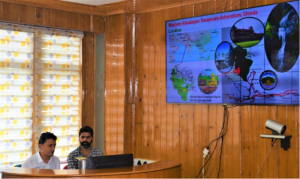Shimla: Having taken great pains to bring together the varied, rare, endangered, threatened and economically important native plant species of the north western and western Himalayan region at one place, the forest department has drawn up plans to create awareness about the arboretum here as an important tourist attraction for nature lovers.

At a meeting of senior forest officers, Principal Chief Conservator Wildlife Rajiv Kumar emphasized that while the arboretum would play a great role in protecting biodiversity, regulated tourism activities needed to be encouraged.
Funded by the forest department, the Western Himalayan Temperate Arboretum (WHTA) project, at Porters Hill, Shimla is being implemented by Himalayan Forest Research Institute (HFRI), Shimla.

HFRI scientist in charge for setting up WHTA Dr Vaneet Jishtu, who from the start has been involved in laying out the arboretum, stated at the meet that most of the botanical gardens and arboreta in the country were in tropical and sub-tropical regions, but in north western India, specially so in the temperate region of Himachal, there hardly were any.
Appreciating the novel initiative of the forest department, Dr Jishtu said, it needed out of the box thinking to venture and bring together all native trees of the region in one place.

More than 120 tree species stand collected from various parts of the Western Himalayan region that have been planted in the arboretum in distinct sections and blocks.
Sections for Gymnosperm, Acer, Rosaceae, Walnut, Rhododendron, Oak, etc. plant species have been setup and nursery for germplasm propagation of lesser-known tree species (LKTS) has also been established.
The arboretum is supported by a Mist Chamber, Shade House, a Bambusetum, an exclusive Salix section and a medicinal plant conservatory.
There is also an exclusive nursery for showcasing the rare Ashtavarga Group of medicinal plants collected from across Himachal Pradesh.
The arboretum registers regular visits by scientists, teachers, foresters, farmers, students and even tourists. Most of them are from other parts of the state and country that generally remain devoid of closer contact with nature, natural resources and environment of Himalaya.

The arboretum has become an important tool in educating visitors in understanding Himalayan nature without going into far flung areas, and make them aware of the importance of conservation of important plant resources of north-western temperate Himalaya.
Western Himalayan Mountain ecosystem is an environment hot spot in need of conservation, with a germplasm establishment being a need of the hour.
Botanical gardens and arboreta devote their resources to the study and conservation of plants, as well as making the native plant species diversity known to the public.
Presided over by Mr Rajiv Kumar (Pr. Chief Conservator of Forests (WL)-cum-Chief Wildlife Warden, Himachal Pradesh) the WHTA Advisory Committee meet held on 2nd September was attended by senior HP State Forest Department officers Mr Anil Kumar Thakur, APCCF and Mr. K. Thirumal, CCF.
Other participants included Dr. Lal Singh, Director, Himalayan Research Group (HRG), Dr. Dhiraj S Rawat, HoD, Department of Botany, H.P University, Shimla, Dr. Rakesh Kumar Singh, Scientist Incharge, G.B Pant Institute, Mohal, Kullu, Dr. Narinder Negi, Scientist, National Bureau of Plant Genetic Resources (NBPGR), and Mr. Hem Thakur, Director, Hail Himalaya, Shimla. The Himalayan Forest Research was represented by Dr. Sandeep Sharma, Director and Dr. Vaneet Jishtu.


